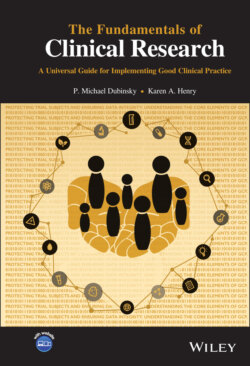Читать книгу The Fundamentals of Clinical Research - P. Michael Dubinsky - Страница 139
11.5 Communication, Reporting, and Oversight
ОглавлениеCommunication is a key role for the regulator as well as the sponsor in terms of a successful CTA application and the regulators generally accommodate, in a reasonable manner, a variety of lines of communication including telephone conversations, letters, facsimile, online message, or meetings. Obviously, such communication will be consistent with the available technology as long as appropriate confidentiality is maintained. It is useful to remember that there is one regulatory authority serving a large number of sponsors/applicants so at times a queue may form. The responsibility for effective lines of communication is a shared one with the sponsor. The regulator must maintain a full and complete administrative record of their interactions with a sponsor if they are to be accountable for making decisions about such matters as starting a clinical trial in humans with a new investigational drug product or other investigational article. The content of the administrative records documenting communication may well be reviewed and evaluated by others and by panels of experts who might be called upon to assist the regulator at some point in making a decision impacting the application.
The regulator will usually identify one central point of contact (POC) for the applicant/sponsor. That POC will be organizationally located in a group which is responsible for such applications or in a group whose responsibilities are grounded in the area of therapeutic treatment being researched. That POC person or office serves as the gateway, either electronically or physically, for communications with the regulator. Regulators almost always enforce the use of a central POC or the potential for miscommunications and misunderstandings is magnified. The POC is not, however, the only person with whom the applicant’s staff will communicate. The regulator’s professional experts in topics such as chemistry, statistical analysis, safety evaluations, etc., will interact as needed with the sponsor’s counterparts but always working through or with the central POC. This approach ensures that the lines of communication remain centralized, complete, and up to date.
By ensuring the centralization of submissions and communications, the regulatory authority has in one place the body of information needed to conduct overall reviews and evaluations should it be necessary. Such evaluations might be needed if a safety issue arose or if a report, e.g. complaint of noncompliance with the protocol were received. ICH E6(R2) speaks to the regulatory authorities’ role in receiving and evaluating such reports especially as it relates to safety information. Most regulators have rules specifying the timing of serious and unexpected safety and adverse drug reaction reports. Such reports may generate additional communications between the regulator and the sponsor/applicant. It is essential that the regulator obtain and review the full body of information concerning adverse reactions which are serious and unexpected so they can weigh, along with the sponsor/applicant, whether the risks associated with the trial have changed and if that change warrants enrollment being halted.
There is a continuous and viable line of communication about the conduct of a clinical trial for which the regulator shares responsibility. This is not to imply that communication is daily or weekly, although that might occur from time to time, but the communication must be timely for the topic or issue at hand.
The regulatory authorities have through regulation and policy a responsibility to ensure that appropriate periodic reports are received from sponsors/applicants about the status of the clinical trial endeavor. These reports are usually termed progress reports and the review and evaluation of them is a role that the regulator is expected to perform. Depending upon the content, or lack thereof the regulator may need to consider some follow‐up action regarding the application. Progress reports must be adequate and complete since they represent a key component of the regulator’s oversight role in clinical trials. Such reports are usually required on an annual basis unless they are specified at different times. If required reports are not received or are found to be inaccurate or incomplete, the regulator may take steps to terminate the study or penalize the sponsor. In most such situations, the regulator, through its POC, will attempt to resolve such matters through communications both informal and formal and documented in the regulator’s file on the study.
Taking and documenting actions on an application throughout its lifecycle is expected of the regulator.
